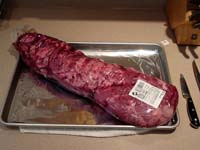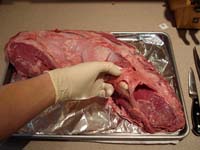 |
 |
|
Trimming a Tenderloin
| Source: |
Alton Brown, Good Eats |
| Yield: |
A 6 pound tenderloin yields 5 pounds beef |
| Serving Size: |
8 oz. |
| Servings: |
10 |
Information for this is from Alton Brown's Good Eats, the Tender is the Loin episode.
Generally, the most tender cuts of meat are high and to the rear of the animal. Sitting near the top of the cow, just under the spine, towards the rear is one of the most tender: the tenderloin. The tenderloin is a lean and versatile piece of meat from which one of the most desired cuts of steak comes: Filet Mignon. That's why tenderloin is also one of the most expensive: an 8 oz. piece of filet can cost anywhere from $20 to $50 at a steak house. |
| |
|
Ingredients
| Trimming a Tenderloin |
| Ingredient |
Amount |
Calories |
Fat (g) |
Carbs (g) |
Prot (g) |
Beef, Tenderloin
|
5 Pound |
3840 |
202 |
0 |
472 |
| Total: |
3840 |
202 |
0 |
472 |
| Per Serving: |
384 |
20.2 |
0 |
47.2 |
|
Even at the grocery store, you can easily pay upwards of $20 per pound. However, if you're willing to do a little work, you could purchase a tenderloin sub-primal (aka PSMO, tenderloin w/ side muscle), trim it yourself and pay just $10/lb for USDA Choice and $15/lb for USDA Prime at your local wholesale club. Since this is a sub-primal (a significant portion of a major cut, the loin) vacuum packed directly by the meat processor, it is essentially wet-aging in it's own juices which will enhance it's tenderness and reduce the chance of contamination. The natural enzymes in the meat and the absence of oxygen inhibit bacterial growth so an unopened PSMO can last a week or two in the fridge. Plus, you'll have the flexibility to cut your meat exactly the way you want.
Instructions
| |
|
click for a larger image |
Here is a nice 8 pound PSMO tenderloin in it's vacuum pack. Note that a 6 pound tenderloin will lose about 1 pound of trimmed fat.
You'll need a large cutting board or half sheet to hold the tenderloin, preferably one that can catch any liquids you lose. You'll also need at least one sharp knife. I used a paring knife but a boning knife will also work well.
|
|
 |
|
The first step is to open the packaging and letting it drain out over the sink. You can do this by cutting a hole in one end, then the other end. Note that the red liquid is not blood; it is primarily water with enzymes, proteins and other compounds from the meat.
To remove the tenderloin from it's packaging, cut the wide end completely open.
Rinse the meat with cold water then blot dry with a few paper towels. You don't need to completely dry it, just stop it from dripping. |
|
 |
|
Find the side of the meat with an outer layer of fat that can be easily pulled off. Using your fingers, separate as much of this fat from the muscle as you can and trim it off.
|
|
 |
|
As you remove the layer of fat, you'll be able to see that the fat surrounds the main tenderloin muscle from the medium sized side muscle and the long fatty "chain." Use your fingers to separate these pieces as much as you can without damaging any of the meat.
|
|
 |
|
Continue to trim the fat and separate the muscles until the major pieces of fat are gone and you can completely separate the muscles.
|
|
 |
|
You'll notice some silvery fibers running through some of the meat. This "silver skin" is connective tissue that is extremely tough and should be removed.
To do this, press your knife underneath and perpendicular to the silver skin fiber to separate it from the meet. Then slide the knife along the fibers so you are sort of scraping the silver skin off of the meat, keeping the knife at a slight angle toward the silver skin.
|
|
 |
|
When you're done, you'll have a nice clean tenderloin.
|
|
 |
|
You'll find that parts of the tenderloin would make great tournadeaus or filet mignons, but other parts will not. For instance the tips will be too small, and the smaller end may be too cut up or the muscle fibers too separated. That's fine, you can cut off the bottom 6-8 inches of the tenderloin and use the large part for cutting steaks and the smaller piece as a roast.
|
|
 |
|
Follow the same procedure with the side muscle and the chain. The side muscle would also make a good roast.
The chain is pretty fatty so you will probably end up butchering the meat in the chain (pun intended) but that's ok, you can use it for something like a cheesesteak. Part of the chain can be seen on the top left, pretty chopped up, and a more intact piece is on the right. The bottom left is the tip cut from the tenderloin.
|
|
 |
|
Wrap your meat tightly in two layers of plastic wrap and refrigerate. You should try to use this meat within a couple days.
When you're ready to cut the tenderloin into steaks use a sharp knife to cut 1-2" thick pieces, sprinkle with salt, pepper and olive oil, then pan sear, grill or broil for a simple filet mignon, or prepare using your favorite tenderloin recipe, perhaps Steak au Poivre or Blue Cheese Stuffed Tenderloin, Cheesesteak or Beef Carpaccio.
|
|
 |
|
|
|
 |
 |









